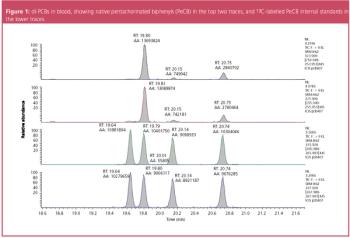Articles by Dirk Krumwiede

Polychlorinated biphenyls (PCBs) are a class of extremely persistent industrial chemicals manufactured for use in electrical transformers, capacitors, inks, paints, pesticides, dust control or insulating fluids. Estimates have put the total global production of PCBs on the order of 1.5 million tons.

This application details a fast, reliable and highly selective trace-level screening method for the quantification of polychlorinated biphenyls (PCBs) in environmental, food and biological samples, using gas chromatography and a triple stage quadrupole mass spectrometer. The analytical strategy is analogous to the well-established US Environmental Protection Agency (USEPA) Method 1668A.

Polybrominated diphenyl ethers (PBDEs) are among the most important and widely used flame retardants. Recent legislation banned certain PBDE congeners.? EU directive 2003/11/EC prohibits the use of Penta-BDE and Octa-BDE for the member states of the European community.? Therefore, analysis of PBDEs have received increased interest as a result of their known toxicity.






